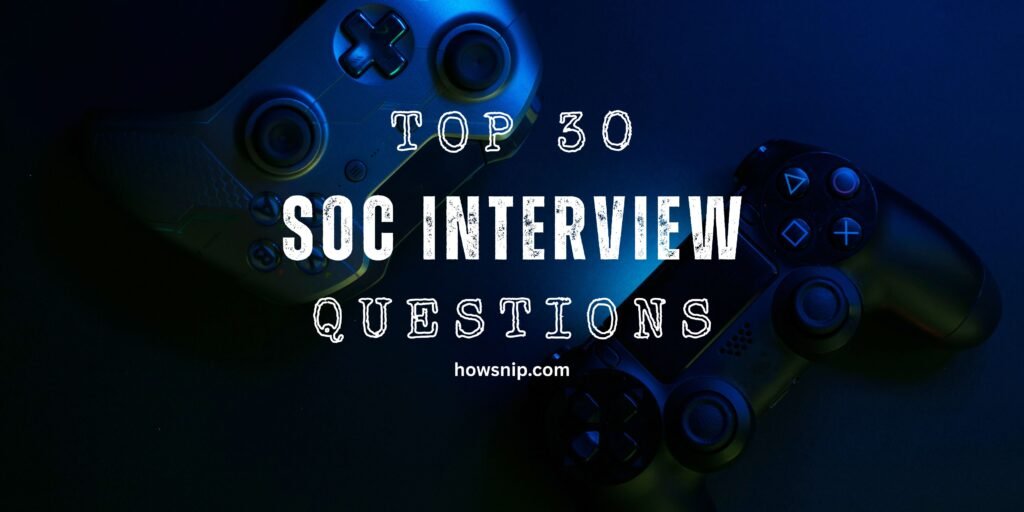This article provides a comprehensive guide for aspiring Security Operations Center (SOC) analysts. It covers essential concepts, industry-standard practices, and practical scenarios frequently discussed in SOC interviews, offering concise explanations to help candidates prepare with confidence for both L1 and L2 roles.
1. What is a Security Operations Center (SOC)?
A Security Operations Center (SOC) is a centralized team or facility that continuously monitors, detects, investigates, and responds to cybersecurity incidents affecting an organization’s information systems and data.
2. What are the primary responsibilities of an L1 SOC Analyst?
An L1 SOC Analyst is responsible for monitoring security alerts, conducting initial triage, documenting findings, and escalating confirmed or high-risk incidents to higher-level analysts for deeper investigation.
3. What is a SIEM and how is it used in SOC operations?
A Security Information and Event Management (SIEM) platform aggregates, normalizes, and analyzes logs from various sources. In the SOC, it enables the real-time detection, investigation, and response to security events.
4. What is the difference between a false positive and a false negative in security alerts?
A false positive is an alert for a benign event mistaken as a threat, while a false negative is a real security incident that fails to trigger an alert, remaining undetected.
5. What is phishing in the context of cybersecurity?
Phishing is a form of social engineering attack where adversaries use deceptive emails or websites to trick users into disclosing sensitive information, such as login credentials or financial details.
6. What steps are typically followed after receiving a security alert?
Upon receiving an alert, an analyst will review the alert details, cross-check logs, validate the nature of the event, search for indicators of compromise (IOCs), and escalate the issue if a real threat is confirmed.
7. What does the CIA triad represent in information security?
The CIA Triad stands for Confidentiality (limiting access to data), Integrity (protecting data accuracy), and Availability (ensuring systems and data are accessible when required).
8. How can suspicious login activity be identified in log data?
Suspicious activity can be flagged by anomalies such as logins from unusual locations, multiple failed authentication attempts, logins at odd hours, or access from unknown devices/IP addresses.
9. What are Indicators of Compromise (IOCs)?
IOCs are artifacts that indicate possible intrusion or compromise, such as known malicious IPs, unusual file hashes, suspicious domains, registry changes, or system artifacts linked to attack patterns.
10. What tools are commonly used to investigate alerts?
SOC analysts use SIEM solutions (e.g., Splunk, IBM QRadar, FortiSIEM, RSA), threat intelligence platforms (TIP), VirusTotal, WHOIS tools, Shodan, and endpoint detection and response (EDR) tools for investigations.
11. What is the function of a firewall?
A firewall acts as a barrier to control and filter network traffic either allowing or blocking data packets based on predefined security rules to protect against unauthorized access.
FortiGate, SonicWall, Palo Alto, Sophos, Gajshield, Cisco ASA and Check Point are among the most commonly used firewalls in enterprise networks.
12. How are alerts prioritized in a SOC environment?
Alerts are prioritized by assessing the potential impact, threat severity, and the criticality of the affected assets ensuring the most significant risks are addressed first.
13. What is triage in cybersecurity incident management?
Triage involves systematically reviewing and categorizing security alerts to identify which events require immediate action, escalation, or further investigation.
14. What is a brute-force attack?
A brute-force attack is a method where attackers systematically try all possible combinations of credentials (such as passwords) to gain unauthorized access to systems.
15. What is the purpose of a ticketing system in SOC operations?
A ticketing system documents, assigns, and tracks the handling of security incidents, ensuring accountability and maintaining a record throughout the incident management lifecycle.
16. How does the role of an L2 SOC Analyst differ from L1?
An L2 SOC Analyst handles escalated incidents, conducts in-depth analyses, assists in incident response, validates the scope and impact, and may proactively hunt for threats.
17. What are the phases of the Incident Response lifecycle?
The incident response lifecycle includes Preparation, Detection & Analysis, Containment, Eradication, Recovery, and Lessons Learned.
18. What is threat hunting in a SOC environment?
Threat hunting is the proactive process of searching through data to identify advanced threats that evade existing security solutions, often guided by hypotheses and threat intelligence.
19. How is malware analysis typically conducted?
Malware analysis involves both static (code review, signature checks) and dynamic (sandbox execution, behavioral observation) analysis to determine a file’s maliciousness.
20. What is meant by lateral movement in a cyberattack?
Lateral movement describes an attacker’s actions to move deeper within a network after the initial breach, seeking to access additional systems or data.
21. How is the MITRE ATT&CK framework utilized in investigations?
MITRE ATT&CK maps observed adversary tactics and techniques, enabling analysts to correlate events with known attack patterns and improve detection and response strategies.
For more info on MITRE ATT&CK, please visit attack.mitre.org.
22. How is log correlation useful in incident investigation?
Log correlation connects events from diverse sources, allowing analysts to uncover relationships, identify complex attack chains, and build a comprehensive picture of incidents.
23. How can a phishing attack be validated?
Phishing can be validated by inspecting email headers, examining embedded URLs, analyzing attachments, verifying sender authenticity, and reviewing user interaction.
24. What steps should be followed when handling a ransomware incident?
Steps include isolating affected systems, identifying ransomware strain, preserving forensic evidence, attempting data recovery, and initiating the organization’s incident response plan.
25. What are some common indicators of privilege escalation?
Indicators include sudden elevation of user privileges, unauthorized access to sensitive data, execution of administrative commands, and changes in privilege group membership.
26. How can a complex incident be resolved and documented?
Resolution requires detailed root cause analysis, eradication of threats, step-by-step documentation of actions taken, impact assessment, and updating of response playbooks.
27. What are threat intelligence feeds and why are they important?
Threat intelligence feeds deliver real-time data on emerging threats (such as IPs, domains, file hashes), helping SOCs stay vigilant and update detection baselines proactively.
Examples of threat intelligence feeds include:
- AlienVault Open Threat Exchange (OTX)
- CrowdSec Threat Intel Feed
- Hunt.io Threat Intelligence Feeds
- Abuse.ch’s malware data feeds
28. How is endpoint telemetry analyzed during an investigation?
Analysts review telemetry from EDR tools to examine process activity, file modifications, registry changes, and suspicious network connections on affected endpoints.
29. What is the purpose of packet analysis tools like Wireshark?
Tools like Wireshark capture and visually inspect network packets to help analysts detect unusual activity, policy violations, or malicious network behavior.
30. How can SOC processes be continuously improved?
SOC processes can be enhanced by fine-tuning detection rules, updating response playbooks, automating repetitive tasks, analyzing incident metrics, and conducting regular team training.


